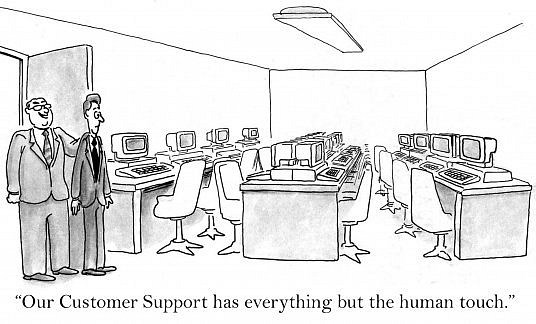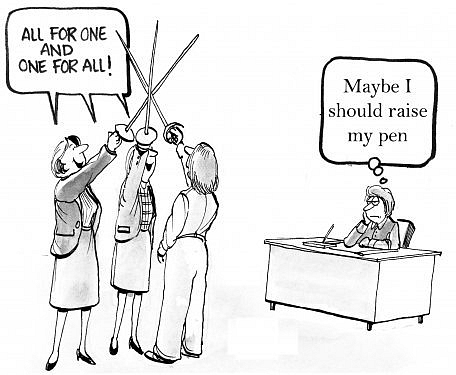All of us have had first-hand experience of it. You are calling into a call centre and not having to wait in IVR for too long, quite quickly, you are getting through to a human being, who greets you with their pleasant voice  . Now, as always when speaking to you, they will verify your contact details too
. Now, as always when speaking to you, they will verify your contact details too  . They will empathetically listen to your problems
. They will empathetically listen to your problems  . They will explain to you that not everything what their colleague from the subsidiary said is true, and they will tell you how things really are
. They will explain to you that not everything what their colleague from the subsidiary said is true, and they will tell you how things really are  . Finally, they will refer you to the online self-service
. Finally, they will refer you to the online self-service  . In the end, you will receive an “irresistible” offer for another product
. In the end, you will receive an “irresistible” offer for another product  and then, having stood your ground refusing it, another, even more “tempting” offer will come flying at you
and then, having stood your ground refusing it, another, even more “tempting” offer will come flying at you  . At the end of the call, before saying good bye to one another, they will thank you for calling
. At the end of the call, before saying good bye to one another, they will thank you for calling  , express delight with successfully solving your problem
, express delight with successfully solving your problem  , and ask you to contact the customer centre again if needed
, and ask you to contact the customer centre again if needed  .
.
Score?
"quality" - 100% (we ticked off everything). Customer eXperience – 0% (nobody has solved your problem, you have lost a lot of time, and you feel stupid; but the agent has followed the manual so it is actually OK). This is the story of how “quality” (or in other words script, quality grid, etc.) killed Customer eXperience. Now, let’s think about how this could be done differently.

How to support Customer eXperience with Quality?
All of us who work in the contact centres field know very well that building a great Customer eXperience requires a huge effort and that it needs support – sometimes literally – from all possible angles. One of the pillars of an excellent Customer eXperience is a simply, realistically, and pragmatically set Quality (the real one, without quotation marks, with a capital letter Q). The key is to have qualitative criteria or scripts which everyone understands. Scripts which are not divorced from reality and work outside of the ideal world, and, at the same time, target the key moments that decide whether the whole Customer eXperience will fly to heaven or sink into the abyss. Well defined criteria also take into consideration the individual context of a call and they appreciate the agent’s empathy, proactivity, and applying common sense.
Consistency – that is what matters
Before you start defining Quality at all, make sure that everyone works with the same information. You may want to say “Of course, it is clear that all of us have the same information”, but…
Answer sincerely the following questions:
- Do all pricelist updates, stock offerings, rules, procedures, etc. get to you (in time)?
- And do all the agents work with them or do they have their own private “knowledge banks” (files, email archives, etc.)?
- Do you really have a view of all guidelines, which impact the customer, across the whole company?
- Is there the same (or at least consistent) information available for customers on the web?
- What if something changes? Do you have a functional process which will ensure (ideally automatically) that all resources are kept up-to-date?
If your answer to any of the above questions is a NO, then you have a problem. There is a risk that someone will tell the customer “Something else”. This inconsistency of yours (mess, chaos, …) is simply impossible to explain. Customer eXperience is going to be “you know where” and not even “quality” tuned to the best possible level will be able to save it.

And what about positively appraising an agent for not having tried to sell? In other words, an agent who made the right decision assessing that an attempt to upsell an enraged customer may have a counterproductive effect? Instead, he planned a callback for a few days later to check with the customer whether their problem was solved. And then, at the right moment, he made the offer, now with a much higer probability of success.
Team discipline
Defining Quality must be teamwork. It is not only about the team of quality controllers, but about all profiles across your contact centre. Do not hesitate to include supervisors, analysts, CX experts, methodology specialists, coaches, and especially agents. Go and invite someone from IT too – they look at things from different angles and can come up with tricks that will make life easier. Remember to clearly define in advance who is entitled to give the final green light as well as to exercise the veto.
Debate, calibrate
Introduce regular calibration meetings. Their aim is to help you to align with one another when it comes to feeling and the way you rate Quality. At these meetings, all participants debate on selected recordings and their individual rating. Do not be afraid to include experienced agents as well – it is them who know your customers and the situations they get into the best. If you gradually come to a conclusion that something in Quality is not right, do not hesitate to change it (for Quality and its perception evolve with time too!).
Does the customer see it the same way?
While setting and calibrating the rating scale for Quality, remember to also take into account the results of customer experience ratings, as your and your clients’ opinions on the meaning of Quality can differ significantly. If they do, it is time to revise your criteria for Quality rating.
Provide a manual, not a blunt script
During your definition and calibration meetings, you surely debated a lot on what to do in various situations. Always have these ideas written down and make them available to your agents, like a cookery book for the scripts. Certainly, they will appreciate it.
Figure it out yourself
Give the agents the access to recordings of their own calls. This way, they get an opportunity to return to calls on which they already received feedback, or they can retrospectively consult a complicated call and seek advice for solving similar cases in the future. The possibility to directly see the rating from the customer gives the agent a valuable opportunity to discover what makes customers happy. If you have the courage to go even further, give your agents the possibility to rate each other’s calls, and then debate and calibrate together. By doing this, you will get a valuable insight into how the rules you set work in practice.
One for all, all for Quality
Are you sure that Quality is important for everybody in your team and that no one’s goals are opposing yours? (For example, the operations management demanding calls be dealt with in the shortest possible time regardless of quality?) After all, you are one team, so besides individual goals deriving from the nature of every single job, it is essential to contribute with your own part to the fulfilment of the general goals of the contact centre. Surely, Quality is one of the main ones.
… and how to make one’s work easier?
There are many ways to do things at your job simply and efficiently. Definitely, sophisticated call recording systems and their quality rating modules rank among those. Another exceptional feature are the voice analyses (also known as the speech analytics), which enable you to pick suspicious calls and consequently focus on them without having to spend hours listening to recordings looking for a needle in a haystack.
Integration of satisfaction assessment data into the quality management system will reduce workload too. Also, get your data analysts involved in the quality improvement process – in their business intelligence tools, they will surely find new perspectives on operational data which you would not even dream about before.
Let’s communicate
We will find solutions to support your strategic goals and achieve your vision.

